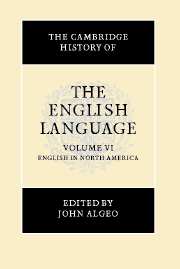Book contents
- Frontmatter
- 1 EXTERNAL HISTORY
- 2 BRITISH AND AMERICAN, CONTINUITY AND DIVERGENCE
- 3 BRITISH AND IRISH ANTECEDENTS
- 4 CONTACT WITH OTHER LANGUAGES
- 5 AMERICANISMS
- 6 SLANG
- 7 DIALECTS
- 8 AFRICAN-AMERICAN ENGLISH
- 9 GRAMMATICAL STRUCTURE
- 10 SPELLING
- 11 USAGE
- 12 CANADIAN ENGLISH
- 13 NEWFOUNDLAND ENGLISH
- 14 American English Abroad
- Glossary of Linguistic Terms
- Bibliography
- Index
- THE CAMBRIDGE HISTORY OF THE ENGLISH LANGUAGE
12 - CANADIAN ENGLISH
Published online by Cambridge University Press: 28 March 2008
- Frontmatter
- 1 EXTERNAL HISTORY
- 2 BRITISH AND AMERICAN, CONTINUITY AND DIVERGENCE
- 3 BRITISH AND IRISH ANTECEDENTS
- 4 CONTACT WITH OTHER LANGUAGES
- 5 AMERICANISMS
- 6 SLANG
- 7 DIALECTS
- 8 AFRICAN-AMERICAN ENGLISH
- 9 GRAMMATICAL STRUCTURE
- 10 SPELLING
- 11 USAGE
- 12 CANADIAN ENGLISH
- 13 NEWFOUNDLAND ENGLISH
- 14 American English Abroad
- Glossary of Linguistic Terms
- Bibliography
- Index
- THE CAMBRIDGE HISTORY OF THE ENGLISH LANGUAGE
Summary
Introduction
Canadian English claims a rather small number of speakers and spans a relatively brief history – the term “Canadian English” was first recorded only in 1854. As a dialect it has typically been described either as an amalgam of British and American features or as a repository of quaint terms such as moose milk. However, as Richard Bailey observes:
Canadian English, though diverse in communities and variable in the speech of individuals, is not a composite of archaic or rustic features or a potpourri of British and American speechways but a true national language.
[1982, 152, emphasis added]It is now generally agreed that Canadian English originated as a variant of northern American English (the speech of New England, New York, New Jersey, and Pennsylvania). Throughout its history, it has been influenced by two powerful external norms, those of British English and American English; the relative prestige of these norms and hence their effect on Canadian English have varied according to the social and political conditions. Nonetheless, Canadian English can be seen as pursuing its own course, with the development of distinctive linguistic features and dialectal forms.
Standard (or general) Canadian English, though perhaps a “scholarly fiction“ (R. Bailey 1982, 152), has traditionally been defined as a class dialect, namely, the variety spoken by educated middle-class urban Canadians from the eastern border of Ontario to Vancouver Island. There is a remarkable homogeneity in speech over this vast area. The differences that mark the major dialects – the English of the Maritimes (Nova Scotia, New Brunswick, and Prince Edward Island), of Quebec (Montreal and the Eastern Townships), and of the Ottawa Valley – from the minor variants found in the West (British Columbia), the Prairies (Alberta, Saskatchewan, and Manitoba), and the Arctic North are quite insignificant.
- Type
- Chapter
- Information
- The Cambridge History of the English Language , pp. 422 - 440Publisher: Cambridge University PressPrint publication year: 2001
- 9
- Cited by

